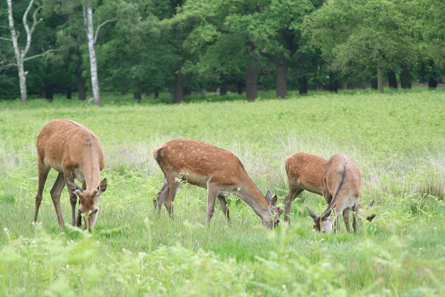Module 8
1. Module 8
1.34. Lesson 9
Module 8—Populations, Individuals, and Gene Pools
Lesson 9—Measuring Growth
 Get Focused
Get Focused

© Christopher Hall/760379/Fotolia
White-tailed deer are browsers. They love the tender buds of shrubs and young trees that make up the transition area between fields and forests. The clearing of forest for residential subdivisions has actually favoured white-tailed deer to a degree because there is more of this transitional browse around the edges of the development, increasing the deer’s food supply.
At the same time that white-tailed deer populations are increasing in size, natural predators of deer, such as coyotes, have been forced out of this habitat by human activity and conflict with human populations. Also, while hunting remains a major means of controlling deer numbers, unlike in early Aboriginal times and times of the early settlers, hunting is no longer the major method humans use to acquire meat. Present-day society largely depends on meat from domestic cows, pigs, and poultry.
With high food supply and without many predators, the density of white-tailed deer is high enough in some areas of North America that they can be considered pests. Today’s hunting regulations are based on research of population numbers done by government branches and independent agents. The resulting yearly hunting regulations are designed to help control the size of natural herds.
The increased density of deer and man’s development of roadways into their habitat have resulted in increased numbers of deer-vehicle collisions as deer attempt to cross highways and roads in their migratory patterns. Many devices have been developed to reduce deer-vehicle collisions, such as fences in National Parks and road reflectors. Another device sends out a very high-pitched sound from cars travelling rural roads. The sound is irritating enough to deer that they are apparently deterred from crossing the road. This may minimize vehicle-deer collisions, but the device can also prevent deer from moving through their natural territories and following their normal migration patterns.
Elk, moose, and other organisms with large, natural territories experience similar population growth patterns where humans have created obstacles to movement, such as roads and railroads.
Wildlife managers study population sizes of wildlife and control their numbers. These studies use effective methods of measuring and expressing the growth of populations.
In this lesson the following focusing questions will be examined:
- How can data be analyzed to study population dynamics?
- How can population data be expressed to give the data meaning?
 Module 8: Lesson 9 Assignment
Module 8: Lesson 9 Assignment
Download a copy of the Module 8: Lesson 9 Assignment to your computer now. You will receive further instructions on how to complete this assignment later in the lesson.
In addition to your lesson work, any summary notes, sample problems, diagrams, charts, or tables should be stored in the course folder for your teacher’s feedback and study purposes as you prepare for exams.
You must decide what to do with the questions that are not marked by the teacher.
Remember that these questions provide you with the practice and feedback that you need to successfully complete this course. You should record the answers to all of the questions and place those answers in your course folder.
You also have the option of trying additional questions from the textbook for further practice. Consult with your teacher for the answers to these questions. The Key will also provide you with many Diploma Exam-style multiple-choice, numeric-response, and written-response questions that will be an excellent review of the module. Practising your responses to these types of questions is good preparation for the Diploma Exam.